-
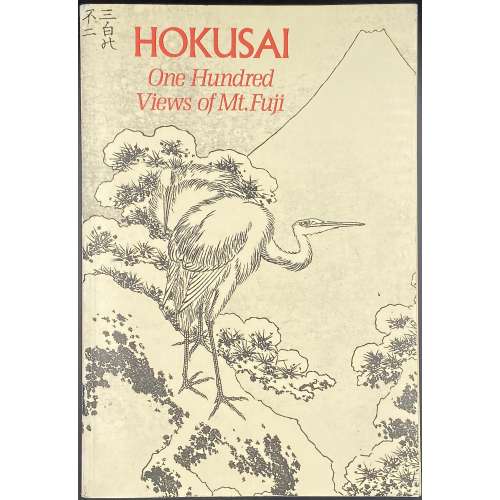 Softcover, 24 x 16.5 cm, publisher's pictorial wrappers, lettering to spine, pp.: [6] 7-224. Full reproduction of Katsushika Hokusai's [葛飾 北斎] (Japanese, 1760 – 1849) series of three illustrated books [絵本, e-hon] One Hundred Views of Mount Fuji [富嶽百景, Fugaku hyakkei], published in Japan in 1834-1849, with commentaries.
Softcover, 24 x 16.5 cm, publisher's pictorial wrappers, lettering to spine, pp.: [6] 7-224. Full reproduction of Katsushika Hokusai's [葛飾 北斎] (Japanese, 1760 – 1849) series of three illustrated books [絵本, e-hon] One Hundred Views of Mount Fuji [富嶽百景, Fugaku hyakkei], published in Japan in 1834-1849, with commentaries. -
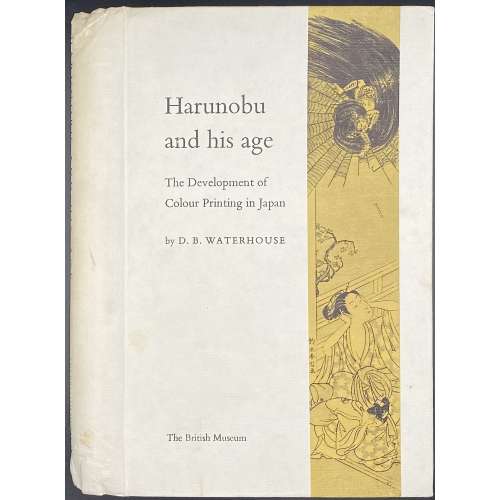
Pictorial cloth boards, spiral-bound, pp.: 3 leaves: h.t., frontis., t.p., 1-326; 123 black & white plates within the pagination.
-
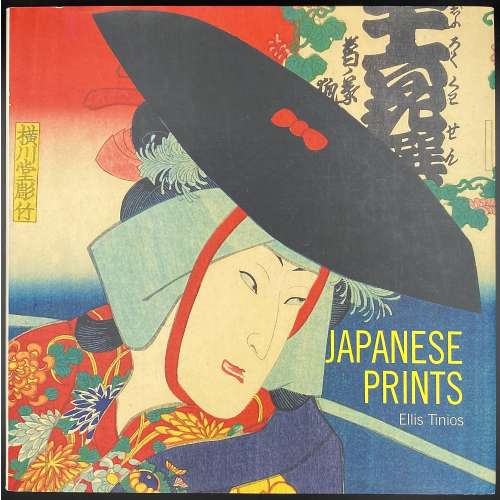 Hardcover, 23.5 x 23.5 cm, publisher's navy cloth, gilt-stamped lettering to spine, pictorial DJ; pp.: [1-6] 7-143 [144 blank].
Hardcover, 23.5 x 23.5 cm, publisher's navy cloth, gilt-stamped lettering to spine, pictorial DJ; pp.: [1-6] 7-143 [144 blank].Japanese woodblock prints of the Edo period (1615-1868) were the products of a highly commercialised and competitive publishing industry. Their content was inspired by the vibrant popular culture that flourished in Edo (Tokyo). At any given time scores of publishers competed for the services of the leading artists of the day. Publishers and artists displayed tremendous ingenuity in finding ways to sustain demand for prints and to circumvent the restrictions placed on the industry through government censorship. Although Japanese prints have long been appreciated in the West for their graphic qualities, their content has not always been fully understood. This book draws on recent scholarship that makes possible a more subtle appreciation of the imagery encountered in the prints and how they would have been read when first made. Through stunning new photography of both well-known and rarely published works in the collection of the British Museum, including many recent acquisitions, the author explores how and why such prints were made, providing a fascinating introduction to a much-loved but little-understood art form.
-
 Hardcover, 30 x 26 cm, publisher's pictorial boards, pp.: [1-5] 6-168, il.
Hardcover, 30 x 26 cm, publisher's pictorial boards, pp.: [1-5] 6-168, il.Published to accompany the recent successful exhibition at the Museu Picasso, Barcelona, this book sheds new light on Picasso's work - his connection with Japanese art. It is illustrated with images
-
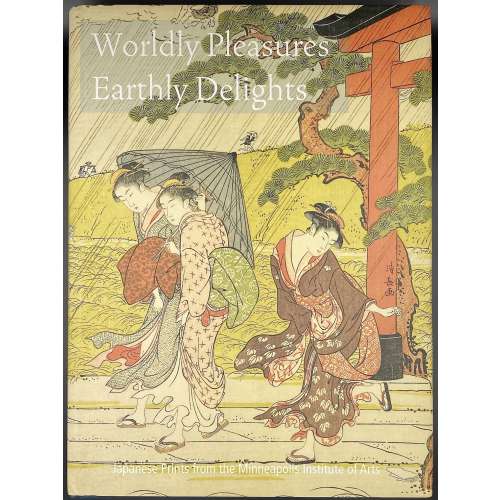 Hardcover, 32 x 23.5 cm, publisher's blue cloth, blind-stamped to cover, gilt lettering to spine, pictorial DJ; pp.: [1-6] 7-375 [376 blank], ill.
Hardcover, 32 x 23.5 cm, publisher's blue cloth, blind-stamped to cover, gilt lettering to spine, pictorial DJ; pp.: [1-6] 7-375 [376 blank], ill.This catalogue features the top ten percent of the collection ... presented in an exhibition ['Great ukiyo-e masters : common pleasures, uncommon prints : Japanese woodcuts from the Minneapolis Institute of Arts', sponsored by Asano Laboratories] that opened in Tokyo at the Shoto Museum of Art on October 2, 2007, and traveled to the Nara Prefectural Museum of Art and the Sanritz Hattori Museum of Arts"--Foreword. "This [2011] publication ... coincides with a special exhibition, 'Edo Pop: Japanese Master Prints from the Minneapolis Institute of Arts' (October 16, 2011, through January 8, 2012), which will [also] be shown at the High Museum of Art in Atlanta ..."--Foreword. "With contributions by Shūgō Asano, Akane Fujisawa, Murasaki Fujisawa, Yuriko Iwakiri, Yōsuke Katō, Junko Mutō, Noriko Yamamoto. Contents: Foreword / Kaywin Feldman Acknowledgments / Matthew Welch, Yuiko Kimura-Tilford Seductive beauty : coveting and collecting Ukiyo-e / Matthew Welch Time line of the artists Catalogue of selected prints Object list in English and Japanese
-
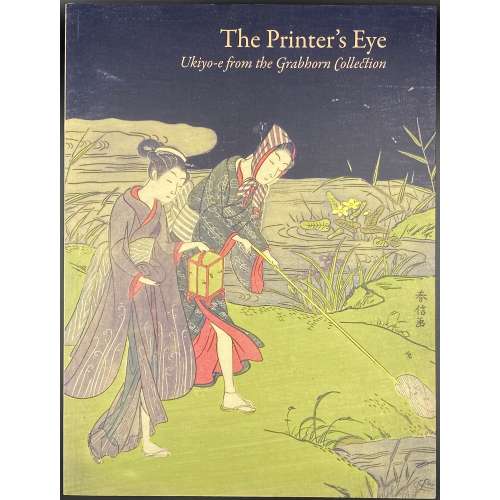 Softcover, pictorial wrappers, pp.: 1-200, il.
Softcover, pictorial wrappers, pp.: 1-200, il.Foreword: A treasure trove of ukiyo-e prints / Kobayashi Tadashi The Grabhorn ukiyo-e collection at the Asian Art Museum / Melissa M. Rinne Edwin Grabhorn : passionate printer and print collector / Julia Meech Figures of humans and animals : some early Japanese color prints from the Grabhorn Collection / David Waterhouse. Edwin Grabhorn (1889—1968), co-founder of the Grabhorn Press, Northern California's premier letterpress printer, was a pioneer American collector of Japanese prints. The Grabhorn prints in the collection of the Asian Art Museum comprise the upper echelons of the original collection. The collection includes a superb selection of early monochrome and hand-colored ukiyo-e prints by Sugimura Jihei, Torii Kiyonobu, Okumura Masanobu and others, from the seminal decades of the woodblock print production in the late 1600s and early 1700s.
-
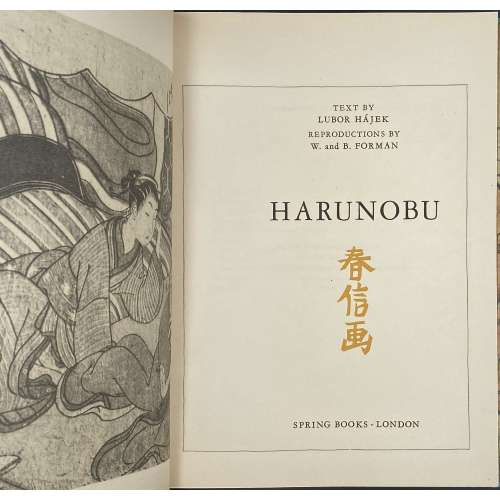 Japanese binding, 2 leaves of pictorial wrappers, [10] 11-63, 10 b/w plates, 63 colour plates within pagination; in a green cloth folder with gilt lettering to front and spine.
Japanese binding, 2 leaves of pictorial wrappers, [10] 11-63, 10 b/w plates, 63 colour plates within pagination; in a green cloth folder with gilt lettering to front and spine. -
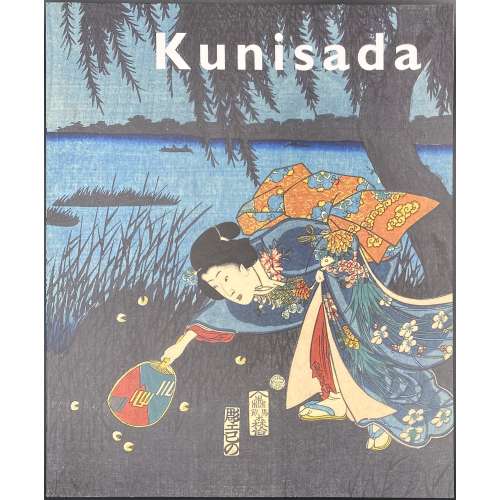 Softcover, publisher’s pictorial wrappers, 29.7 x 24.6 cm, pp.: [1-3] 4-174 [2 blank], ils.; total 88 leaves. Title-page: Kunisada | imaging | drama and beauty | Robert Schaap | with an introduction by Sebastian Izzard | and contributions by Paul Griffith and Henk. J. Herwig | {publisher’s device} Hotei Publishing || Contents: Preface / Robert Schaap & Chris Uhlenbeck; Lenders to the exhibition & catalogue: notes to readers; Utagawa Kunisada, the artist and his times / Sebastian Izzard; Catalogue / Robert Schaap with Paul Griffith, Henk J. Herwig & Sebastian Izzard. Subjects: Utagawa, Kunisada, — 1786-1864 — Catalogs; Color prints, Japanese — Edo period, 1600-1868 — Catalogs; Ukiyo-e — Catalogs. Contributors: Sebastian Izzard Paul Griffith Henk. J. Herwig Utagawa Kunisada [歌川 国貞] a.k.a. Utagawa Toyokuni III [三代歌川豊国] (Japanese, 1786 – 1865) Select illustrations (references in this collection):
Softcover, publisher’s pictorial wrappers, 29.7 x 24.6 cm, pp.: [1-3] 4-174 [2 blank], ils.; total 88 leaves. Title-page: Kunisada | imaging | drama and beauty | Robert Schaap | with an introduction by Sebastian Izzard | and contributions by Paul Griffith and Henk. J. Herwig | {publisher’s device} Hotei Publishing || Contents: Preface / Robert Schaap & Chris Uhlenbeck; Lenders to the exhibition & catalogue: notes to readers; Utagawa Kunisada, the artist and his times / Sebastian Izzard; Catalogue / Robert Schaap with Paul Griffith, Henk J. Herwig & Sebastian Izzard. Subjects: Utagawa, Kunisada, — 1786-1864 — Catalogs; Color prints, Japanese — Edo period, 1600-1868 — Catalogs; Ukiyo-e — Catalogs. Contributors: Sebastian Izzard Paul Griffith Henk. J. Herwig Utagawa Kunisada [歌川 国貞] a.k.a. Utagawa Toyokuni III [三代歌川豊国] (Japanese, 1786 – 1865) Select illustrations (references in this collection):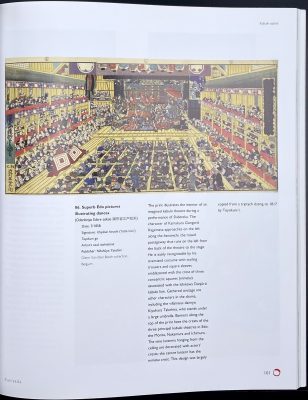
SVJP-0226.2016: Superb Edo pictures illustrating dances, 1858.
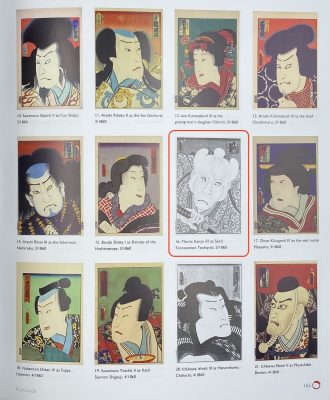
SVJP-0221.2016: Actor Morita Kan’ya XI as Saito Tarozaemon Toshiyuki, 1860.

SVJP-0228.2017: Matsumoto Kōshirō V (Japanese, 1764-1838) as Nikki Danjō Saemon Naonori, 1863.
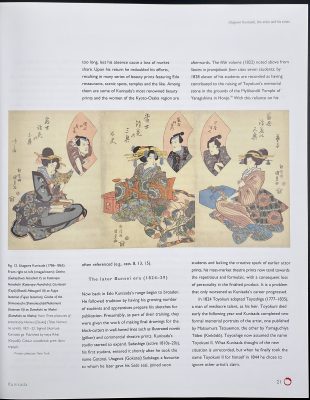
SVJP-0197.2015: Three Pleasures of Present-day Osaka (Tōsei Naniwa no sankō), 1821.
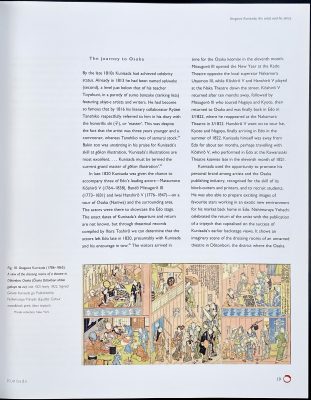
SVJP-0222.2016: A view of the dressing room of a Theater in Dōtonbori, Ōsaka, 1821-2.
-
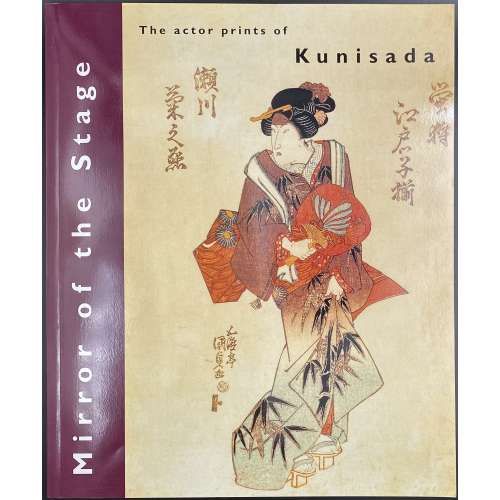 Thin booklet in glossy pictorial wrappers, 29.8 x 24.7 cm, pp.: [1-4] 5-48, 24 leaves total, illustrated. Errata tipped in after the front wrapper. Title-page: Mirror | of the stage | The actor prints of | Kunisada | Ellis Tinios | The University Gallery Leeds || Colophon: Published in March 1996 for the exhibition Mirror of the Stage held at the University Gallery Leeds 24 April-30 May 1996. Introduction: "This book [exhibition catalogue] has been written as an introduction to nineteenth-century Japanese colour woodblock actor prints and to the achievements of the artist Kunisada in that field [as well as to accompany the exhibition of the same name]. It is divided into three sections. In the first, I examine four topics: the social and cultural milieu that gave rise to the production of prints as items of mass consumption; the aesthetic of the actor print; the economics of print production (including consideration of the numbers issued, the prices at which they were sold and their rates of survival); and the process by which prints were produced. The second section consists of sixteen colour plates with commentaries. In the final section, I survey Kunisada's career." Subject: Utagawa, Kunisada, — 1786-1864 — Exhibitions; Ukiyo-e — Exhibitions; Colour prints, Japanese — Edo period, 1600-1868 — Exhibitions. Contributors: Ellis Tinios Utagawa Kunisada [歌川 国貞] a.k.a. Utagawa Toyokuni III [三代歌川豊国] (Japanese, 1786 – 1865). Select illustrations (references in this collection):
Thin booklet in glossy pictorial wrappers, 29.8 x 24.7 cm, pp.: [1-4] 5-48, 24 leaves total, illustrated. Errata tipped in after the front wrapper. Title-page: Mirror | of the stage | The actor prints of | Kunisada | Ellis Tinios | The University Gallery Leeds || Colophon: Published in March 1996 for the exhibition Mirror of the Stage held at the University Gallery Leeds 24 April-30 May 1996. Introduction: "This book [exhibition catalogue] has been written as an introduction to nineteenth-century Japanese colour woodblock actor prints and to the achievements of the artist Kunisada in that field [as well as to accompany the exhibition of the same name]. It is divided into three sections. In the first, I examine four topics: the social and cultural milieu that gave rise to the production of prints as items of mass consumption; the aesthetic of the actor print; the economics of print production (including consideration of the numbers issued, the prices at which they were sold and their rates of survival); and the process by which prints were produced. The second section consists of sixteen colour plates with commentaries. In the final section, I survey Kunisada's career." Subject: Utagawa, Kunisada, — 1786-1864 — Exhibitions; Ukiyo-e — Exhibitions; Colour prints, Japanese — Edo period, 1600-1868 — Exhibitions. Contributors: Ellis Tinios Utagawa Kunisada [歌川 国貞] a.k.a. Utagawa Toyokuni III [三代歌川豊国] (Japanese, 1786 – 1865). Select illustrations (references in this collection):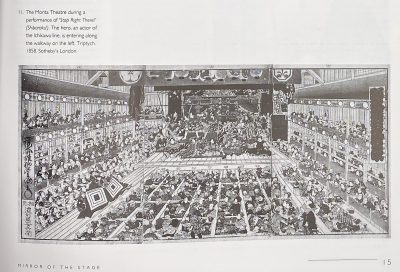
SVJP-0226.2016: Superb Edo pictures illustrating dances, 1858.
-
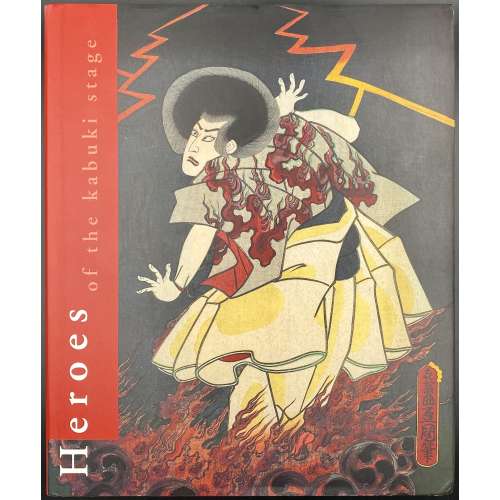 One hardcover volume, 30.2 x 25.3 cm, in red cloth blind stamped to front and spine with lettering, in pictorial dust jacket; pp.: [1-4] 5-359 [360], total 180 leaves, profusely illustrated. Subject: Japan; Theatre; Kabuki theatre; Kabuki actors; Woodblock prints. Contributors: Arendie Herwig (Dutch, fl. 2002 – 2016); Henk Herwig (Dutch, fl. 2002 – 2017).
One hardcover volume, 30.2 x 25.3 cm, in red cloth blind stamped to front and spine with lettering, in pictorial dust jacket; pp.: [1-4] 5-359 [360], total 180 leaves, profusely illustrated. Subject: Japan; Theatre; Kabuki theatre; Kabuki actors; Woodblock prints. Contributors: Arendie Herwig (Dutch, fl. 2002 – 2016); Henk Herwig (Dutch, fl. 2002 – 2017). -
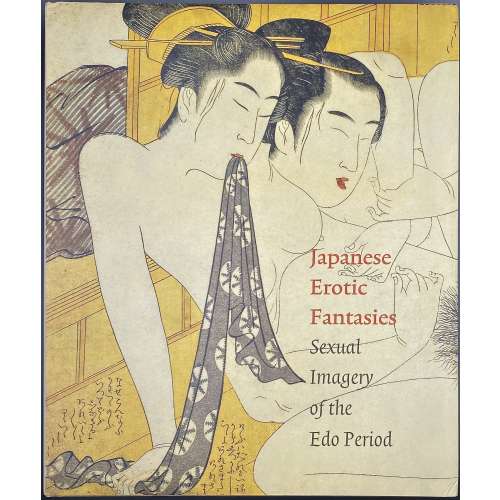 Hardcover volume, 30 x 25.5 cm, in brown cloth with yellow lettering to front cover and spine, in pictorial dust jacket, profusely illustrated in colour; pp.: [1-5] 6-256, total 128 leaves. Title-page (red and black): Japanese | Erotic | Fantasies | Sexual | Imagery | of the | Edo Period | Chris Uhlenbeck and | Margarita Winkel | with contributions by | Ellis Tinios | Cecilia Segawa Seigle | Oikawa Shigeru | Editor Amy Reigle Newland | {publisher’s device} Hotei Publishing, Amsterdam || Contents: Preface by Chris Uhlenbeck; Acknowledgements by Chris Uhlenbeck & Margarita Winkel; Editorial Notes; Shunga: the Issues by Chris Uhlenbeck; The Setting for shunga: the Yoshiwara by Cecilia Segawa Seigle; Erotic Books in the Floating World of Urban Life by Margarita Winkel; The Catalogue ('The Primitives'; The Age of Harunobu, Kiyonaga and Utamaro; The Nineteenth Century; The Meiji Period and Beyond); Appendix: Japanese characters for book, print and series titles; Glossary; Bibliography; General Index; Artists' Index. This publication coincides with the Exhibition "Desire of Spring. Erotic Fantasies in Edo Japan" from 22 January to 17 April 2005 in the Kunsthal Rotterdam (Impressum). Literaturverzeichnis: Seiten 247-250. Contributors: Chris Uhlenbeck Margarita Winkel Ellis Tinios Cecilia Segawa Seigle Oikawa Shigeru Amy Reigle Newland In this collection:
Hardcover volume, 30 x 25.5 cm, in brown cloth with yellow lettering to front cover and spine, in pictorial dust jacket, profusely illustrated in colour; pp.: [1-5] 6-256, total 128 leaves. Title-page (red and black): Japanese | Erotic | Fantasies | Sexual | Imagery | of the | Edo Period | Chris Uhlenbeck and | Margarita Winkel | with contributions by | Ellis Tinios | Cecilia Segawa Seigle | Oikawa Shigeru | Editor Amy Reigle Newland | {publisher’s device} Hotei Publishing, Amsterdam || Contents: Preface by Chris Uhlenbeck; Acknowledgements by Chris Uhlenbeck & Margarita Winkel; Editorial Notes; Shunga: the Issues by Chris Uhlenbeck; The Setting for shunga: the Yoshiwara by Cecilia Segawa Seigle; Erotic Books in the Floating World of Urban Life by Margarita Winkel; The Catalogue ('The Primitives'; The Age of Harunobu, Kiyonaga and Utamaro; The Nineteenth Century; The Meiji Period and Beyond); Appendix: Japanese characters for book, print and series titles; Glossary; Bibliography; General Index; Artists' Index. This publication coincides with the Exhibition "Desire of Spring. Erotic Fantasies in Edo Japan" from 22 January to 17 April 2005 in the Kunsthal Rotterdam (Impressum). Literaturverzeichnis: Seiten 247-250. Contributors: Chris Uhlenbeck Margarita Winkel Ellis Tinios Cecilia Segawa Seigle Oikawa Shigeru Amy Reigle Newland In this collection: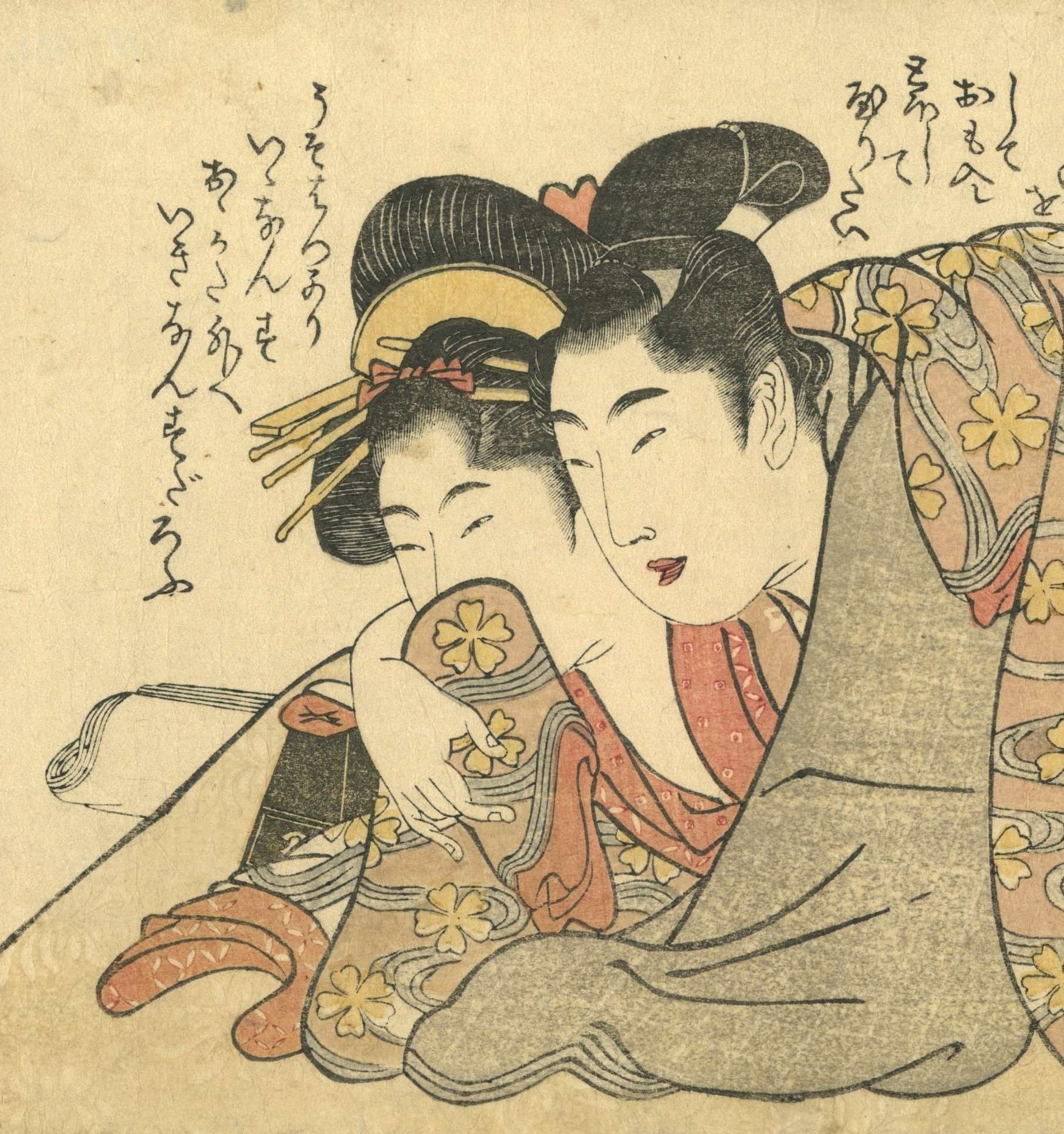
SVJP-0188.2015: Kitagawa Utamaro. Series of horizontal o-hosoban shunga prints, c. 1803.
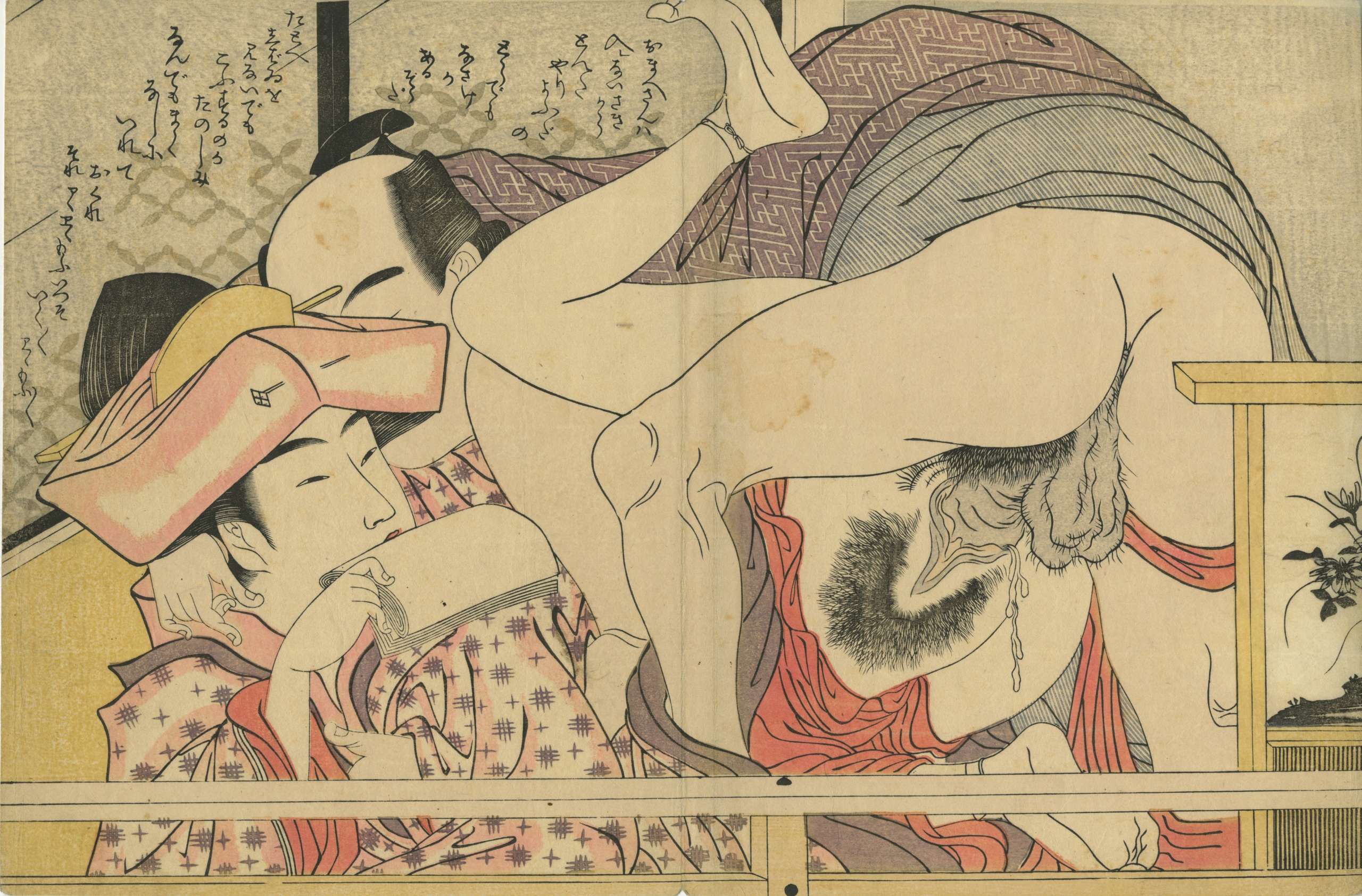
SVJP-0034.2014: Chōkyōsai Eiri. Neat version of a love letter (Fumi no kiyogaki), 1801.

SVJP-0041.2013: Torii Kiyonaga. Handscroll for the sleeve (Sode no maki), c. 1785.
-
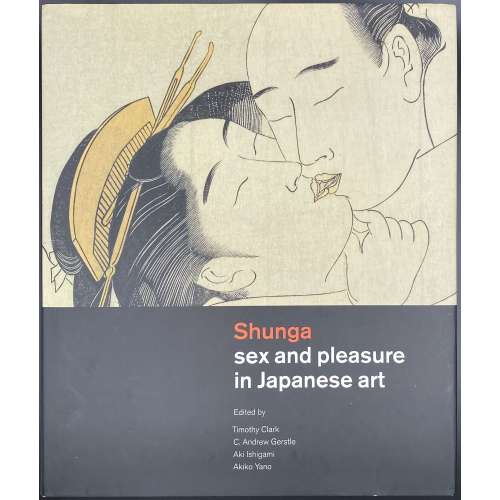 Hardcover volume, 29.6 x 25 x 4 cm, in red cloth with black lettering to spine, in pictorial dust jacket, profusely illustrated in colour; pp.: [1-6] 7-536, total 268 leaves and 2 folding plates extraneous to collation. Title-page: {Hotei's device} Hotei Publishing | Shunga | sex and pleasure in Japanese art | Edited by | Timothy Clark | C. Andrew Gerstle | Aki Ishigami | Akiki Yano || Contents: The Cultural Historical Significance and Importance of Japanese Shunga / Kobayashi Tadashi. Introduction: What Was Shunga? / C. Andrew Gerstle; Who Were the Audiences for Shunga? / Hayakawa Monta. (1) Early Shunga before 1765: Shunga Paintings before the `Floating World' / Akiko Yano; Chinese Chunhua and Japanese Shunga / Ishigami Aki; Shunga and the Rise of Print Culture / Asano Shugo. (2) Masterpieces of Shunga 1765-1850: The Essence of Ukiyo-e Shunga / Kobayashi Tadashi; Erotic Books as Luxury Goods / Ellis Tinios; Listening to the Voices in Shunga / Hayakawa Monta; The Tale of Genji in Shunga / Sato Satoru. (3) Censorship: Timeline of Censorship; Shunga and Censorship in the Edo Period (1600-1868) / Jennifer Preston; Graph of approximate output of shunga print series and books; The Censorship of Shunga in the Modern Era / Ishigami Aki; Shunga Studies in the Showa Era (1926-89) / Shirakura Yoshihiko. (4) Contexts for Shunga: Traditional Uses of Shunga / Yamamoto Yukari; The Distribution and Circulation of Erotic Prints and Books in the Edo Period Laura Moretti; Shunga and Parody / C. Andrew Gerstle; Popular Cults of Sex Organs in Japan / Suzuki Kenko; Grotesque Shunga / Ishigami Aki; Violence in Shunga / Higuchi Kazutaka; Foreign Connections in Shunga / Timon Screech; Children in Shunga / Akiko Yano; Shunga and the Floating World / Matsuba Ryoko. (5) Shunga in the Meiji Era: Erotic Art of the Meiji Era (1868-1912) / Rosina Buckland; The Modern West's Discovery of Shunga / Ricard Bru. Published to accompany the exhibition Shunga: sex and pleasure in Japanese art at the British Museum from 3 October 2013 to 5 January 2014. Abstract: This catalogue aims to answer some key questions about what is shunga and why it was produced. In particular, the social and cultural contexts for sex art in Japan are explored. Erotic Japanese art was heavily suppressed in Japan from the 1870s onwards as part of a process of cultural 'modernisation' that imported many contemporary western moral values. Only in the last twenty years or so has it been possible to publish unexpurgated examples in Japan and this landmark book places erotic Japanese art in its historical and cultural context for the first time. This book looks at painted and printed erotic images produced in Japan during the Edo period (1600-1868) and early Meiji era (1868-1912). These are related to the wider contexts of literature, theatre, the culture of the pleasure quarters, and urban consumerism; and interpreted in terms of their sensuality, reverence, humour and parody. Contributors: Timothy Clark (British, b. 1959) Timothy Clark (British, b. 1959) C. Andrew Gerstle (American, 1951) Aki Ishigami [石上阿希] (Japanese) Akiki Yano
Hardcover volume, 29.6 x 25 x 4 cm, in red cloth with black lettering to spine, in pictorial dust jacket, profusely illustrated in colour; pp.: [1-6] 7-536, total 268 leaves and 2 folding plates extraneous to collation. Title-page: {Hotei's device} Hotei Publishing | Shunga | sex and pleasure in Japanese art | Edited by | Timothy Clark | C. Andrew Gerstle | Aki Ishigami | Akiki Yano || Contents: The Cultural Historical Significance and Importance of Japanese Shunga / Kobayashi Tadashi. Introduction: What Was Shunga? / C. Andrew Gerstle; Who Were the Audiences for Shunga? / Hayakawa Monta. (1) Early Shunga before 1765: Shunga Paintings before the `Floating World' / Akiko Yano; Chinese Chunhua and Japanese Shunga / Ishigami Aki; Shunga and the Rise of Print Culture / Asano Shugo. (2) Masterpieces of Shunga 1765-1850: The Essence of Ukiyo-e Shunga / Kobayashi Tadashi; Erotic Books as Luxury Goods / Ellis Tinios; Listening to the Voices in Shunga / Hayakawa Monta; The Tale of Genji in Shunga / Sato Satoru. (3) Censorship: Timeline of Censorship; Shunga and Censorship in the Edo Period (1600-1868) / Jennifer Preston; Graph of approximate output of shunga print series and books; The Censorship of Shunga in the Modern Era / Ishigami Aki; Shunga Studies in the Showa Era (1926-89) / Shirakura Yoshihiko. (4) Contexts for Shunga: Traditional Uses of Shunga / Yamamoto Yukari; The Distribution and Circulation of Erotic Prints and Books in the Edo Period Laura Moretti; Shunga and Parody / C. Andrew Gerstle; Popular Cults of Sex Organs in Japan / Suzuki Kenko; Grotesque Shunga / Ishigami Aki; Violence in Shunga / Higuchi Kazutaka; Foreign Connections in Shunga / Timon Screech; Children in Shunga / Akiko Yano; Shunga and the Floating World / Matsuba Ryoko. (5) Shunga in the Meiji Era: Erotic Art of the Meiji Era (1868-1912) / Rosina Buckland; The Modern West's Discovery of Shunga / Ricard Bru. Published to accompany the exhibition Shunga: sex and pleasure in Japanese art at the British Museum from 3 October 2013 to 5 January 2014. Abstract: This catalogue aims to answer some key questions about what is shunga and why it was produced. In particular, the social and cultural contexts for sex art in Japan are explored. Erotic Japanese art was heavily suppressed in Japan from the 1870s onwards as part of a process of cultural 'modernisation' that imported many contemporary western moral values. Only in the last twenty years or so has it been possible to publish unexpurgated examples in Japan and this landmark book places erotic Japanese art in its historical and cultural context for the first time. This book looks at painted and printed erotic images produced in Japan during the Edo period (1600-1868) and early Meiji era (1868-1912). These are related to the wider contexts of literature, theatre, the culture of the pleasure quarters, and urban consumerism; and interpreted in terms of their sensuality, reverence, humour and parody. Contributors: Timothy Clark (British, b. 1959) Timothy Clark (British, b. 1959) C. Andrew Gerstle (American, 1951) Aki Ishigami [石上阿希] (Japanese) Akiki Yano -
 Artist: Katsukawa Shunkō [勝川 春好] (Japanese, 1743 – 1812).
Artist: Katsukawa Shunkō [勝川 春好] (Japanese, 1743 – 1812).Actor: Matsumoto Kōshirō IV [[松本幸四郎]; other names: Omegawa Kyōjūrō, Ichikawa Komazō II, Ichikawa Somegorô I, Ichikawa Takejūrō, Segawa Kinji, Segawa Kingo] (Japanese, 1737 – 1802).
Signed: Shunkō ga. Size: Hosoban; 14 x 33 cm. SOLD -
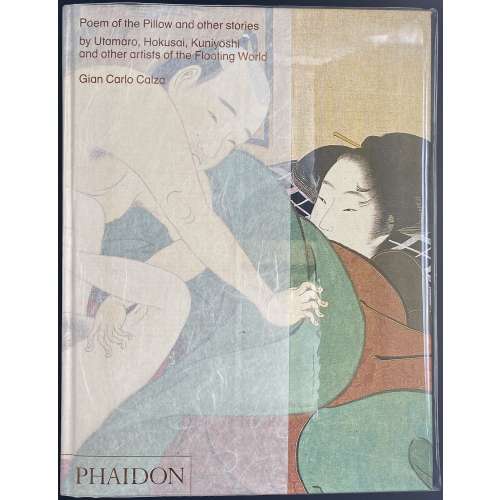 A pictorial album with almost no information (coffee-table book), hardcover, 28 x 21 x 4.8 cm, in pictorial paper boards, lettered all over, in transparent plastic dust jacket; pp.: [1-5] 6-463 [464 colophon], total 232 leaves, illustrated in colour throughout. Title-page: Poem of the Pillow and other stories | by Utamaro, Hokusai, Kuniyoshi | and other artists of the Floating World | Gian Carlo Calza | In collaboration with Stefania Piotti | {publisher’s device “Φ” in the bottom} || Contributors: Gian Carlo Calza (Italian, b. 1940); Stefania Piotti (Italian).
A pictorial album with almost no information (coffee-table book), hardcover, 28 x 21 x 4.8 cm, in pictorial paper boards, lettered all over, in transparent plastic dust jacket; pp.: [1-5] 6-463 [464 colophon], total 232 leaves, illustrated in colour throughout. Title-page: Poem of the Pillow and other stories | by Utamaro, Hokusai, Kuniyoshi | and other artists of the Floating World | Gian Carlo Calza | In collaboration with Stefania Piotti | {publisher’s device “Φ” in the bottom} || Contributors: Gian Carlo Calza (Italian, b. 1940); Stefania Piotti (Italian).
List of the artists: The Kanbun Master, Hishikawa Moronobu, Sugimura Jihei, Torii Kiyonobu I, Nishikawa Sukenobu, Miyagawa Chōshun, Okumura Masanobu, Tsukioka Settei, Suzuki Harunobu, Isoda Koryūsai, Katsukawa Shunshō, Katsukawa Shunchō, Kitao Masanobu, Torii Kiyonaga, Kitagawa Utamaro, Chōbunsai Eishi, Chōkyōsai Eiri, Katsushika Hokusai, Utagawa Toyokuni, Utagawa Kunisada, Kikugawa Eizan, Keisai Eisen, Utagawa Kuniyoshi."Poem of the Pillow and Other Stories examines the artistic developments of Japanese erotic art from the ukiyo-e period, dating from the mid-seventeenth century to the end of the nineteenth century. Known by the delicate euphemism of Shunga or 'spring images', these pictures were hugely popular and admired, and are today highly collectable works of art. This book illustrates major Shunga works from important ukiyo-e masters such as Utamaro, Hokusai, Harunobu, Kunisada, Kuniyoshi and many others. World-renowned scholar Gian Carlo Calza defines these fascinating erotic works in their social, historical and artistic context, providing a broad overview of a subject that is extremely nuanced and intriguing. Beautifully illustrated with over 300 images, including woodblock prints, scrolls and paintings, this book is a perfect introduction to ukiyo-e erotic art." -
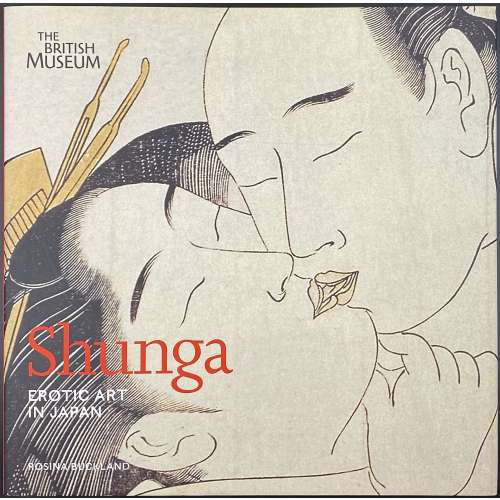 A hardcover pictorial album, 25 x 25.5 cm, bound in black buckram with silver lettering to spine, in pictorial dust jacket; pp.: [1-6] 7-175 [176 blank], total 88 leaves, illustrated in colour throughout. Title-page: Shunga | EROTIC ART | IN JAPAN | ROSINA BUCKLAND | THE BRITISH MUSEUM PRESS || Subject: Art, Japanese – Edo period, 1600-1868; Erotic art – Japan; Prints, Japanese – History. Contributor: Rosina Buckland (British, b. 1974)
A hardcover pictorial album, 25 x 25.5 cm, bound in black buckram with silver lettering to spine, in pictorial dust jacket; pp.: [1-6] 7-175 [176 blank], total 88 leaves, illustrated in colour throughout. Title-page: Shunga | EROTIC ART | IN JAPAN | ROSINA BUCKLAND | THE BRITISH MUSEUM PRESS || Subject: Art, Japanese – Edo period, 1600-1868; Erotic art – Japan; Prints, Japanese – History. Contributor: Rosina Buckland (British, b. 1974) -
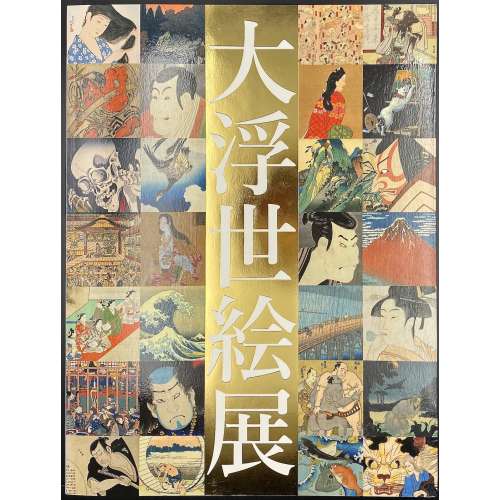 Softcover volume 29.8 x 22.7 cm in publisher’s flapped pictorial wrappers, lettered in Japanese; pp.: [1-4] 5-365 [3], total 184 leaves; pp. 26-267 present 438 illustrations, text in Japanese and English. Reference in this collection: SVJP-0234.2018 – here it is also described as a diptych.
Softcover volume 29.8 x 22.7 cm in publisher’s flapped pictorial wrappers, lettered in Japanese; pp.: [1-4] 5-365 [3], total 184 leaves; pp. 26-267 present 438 illustrations, text in Japanese and English. Reference in this collection: SVJP-0234.2018 – here it is also described as a diptych.
№ 358, p. 226. Bandō Mitsugorō III as Grand arbiter Kiyosumi and Arashi Koroku IV as Koganosuke.
-
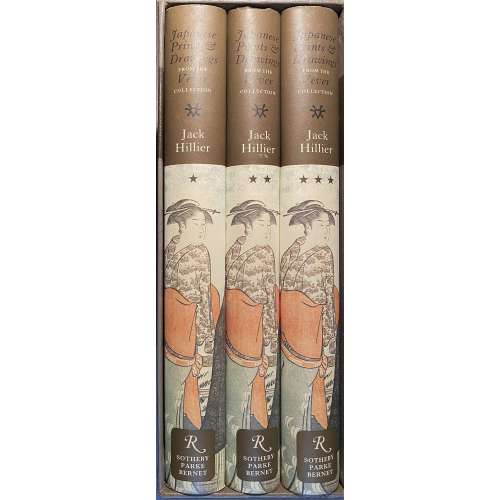 Description: Three volumes, in brown cloth, gilt-lettered to front and spine, in pictorial dust jacket, 34 x 25 cm each, T.E.G., in a slipcase 35 x 25.5 x 13.5 cm. Pagination: Vol. 1: [i-vi] vii-xix [xx] 1-349 [1 blank], ils. №№ 1-382; Vol. 2: [7] 350-673 [1], ils. №№ 383-667 ; Vol. 3: [7] 674-1034, ils. №№ 668-973. Edition: Limited edition of 2,000 copies of which this is copy № 935. Title-page: JACK HILLIER | Japanese Prints | & Drawings from | the Vever Collection | Volume One (Two; Three) | Rizzoli International | Sotheby Parke Bernet | 1976 || Contributors: Jack Ronald Hillier (British, 1912 – 1995) Henri Vever (French, 1854 – 1942)
Description: Three volumes, in brown cloth, gilt-lettered to front and spine, in pictorial dust jacket, 34 x 25 cm each, T.E.G., in a slipcase 35 x 25.5 x 13.5 cm. Pagination: Vol. 1: [i-vi] vii-xix [xx] 1-349 [1 blank], ils. №№ 1-382; Vol. 2: [7] 350-673 [1], ils. №№ 383-667 ; Vol. 3: [7] 674-1034, ils. №№ 668-973. Edition: Limited edition of 2,000 copies of which this is copy № 935. Title-page: JACK HILLIER | Japanese Prints | & Drawings from | the Vever Collection | Volume One (Two; Three) | Rizzoli International | Sotheby Parke Bernet | 1976 || Contributors: Jack Ronald Hillier (British, 1912 – 1995) Henri Vever (French, 1854 – 1942) -
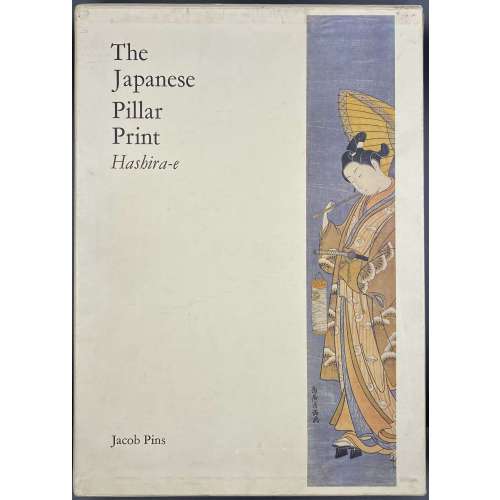 Description: Hardcover volume, 35 x 25.1 cm, ochre cloth with gilt lettering and vignette to spine; pp.: [1-6] 7-389 [3 blank], total 196 leaves, 16 illustrations in colour, 1067 in b/w; in a pictorial slipcase 36 x 26 cm. Title-page: The | Japanese | Pillar | Print | Hashira-e | — | Jacob Pins | Foreword by Roger Keyes | {publisher’s device} | Robert G. Sawers Publishing | 5 SOUTH VILLAS | LONDON NW I 9 BS || Edition: Limited edition of 1000 copies, this is copy № 520. Contributors: Jacob Otto Pins (German-Israeli, 1917 – 2005) Roger Keyes (American, 1942 – 2020)
Description: Hardcover volume, 35 x 25.1 cm, ochre cloth with gilt lettering and vignette to spine; pp.: [1-6] 7-389 [3 blank], total 196 leaves, 16 illustrations in colour, 1067 in b/w; in a pictorial slipcase 36 x 26 cm. Title-page: The | Japanese | Pillar | Print | Hashira-e | — | Jacob Pins | Foreword by Roger Keyes | {publisher’s device} | Robert G. Sawers Publishing | 5 SOUTH VILLAS | LONDON NW I 9 BS || Edition: Limited edition of 1000 copies, this is copy № 520. Contributors: Jacob Otto Pins (German-Israeli, 1917 – 2005) Roger Keyes (American, 1942 – 2020)


